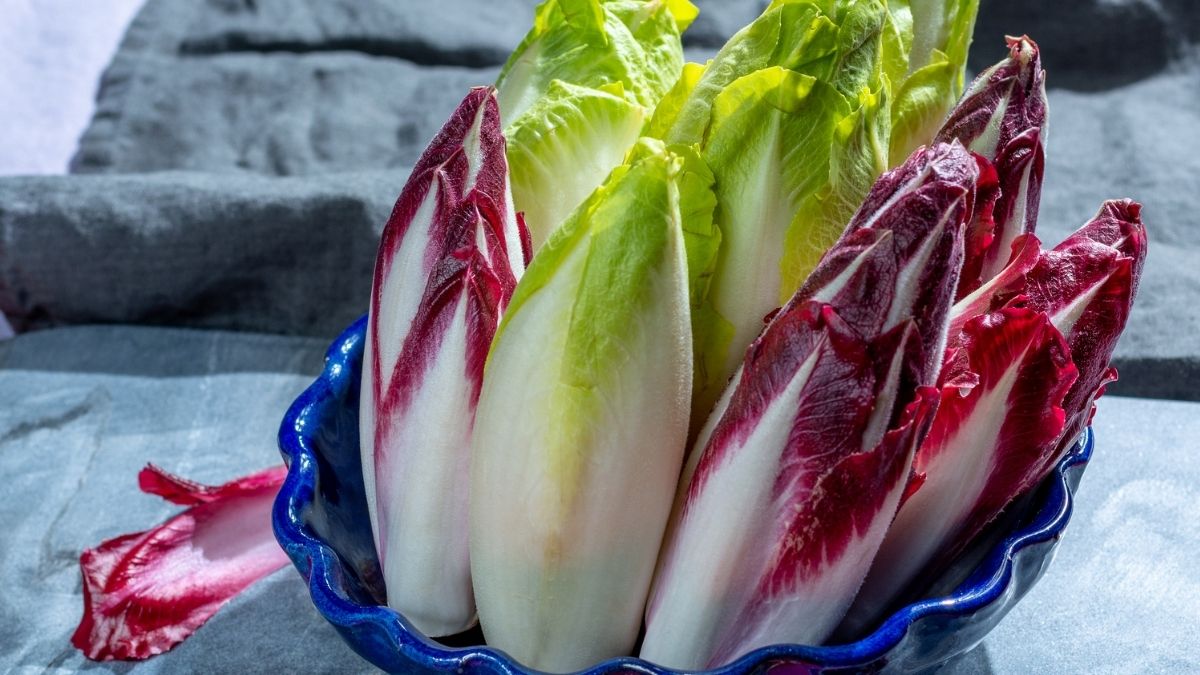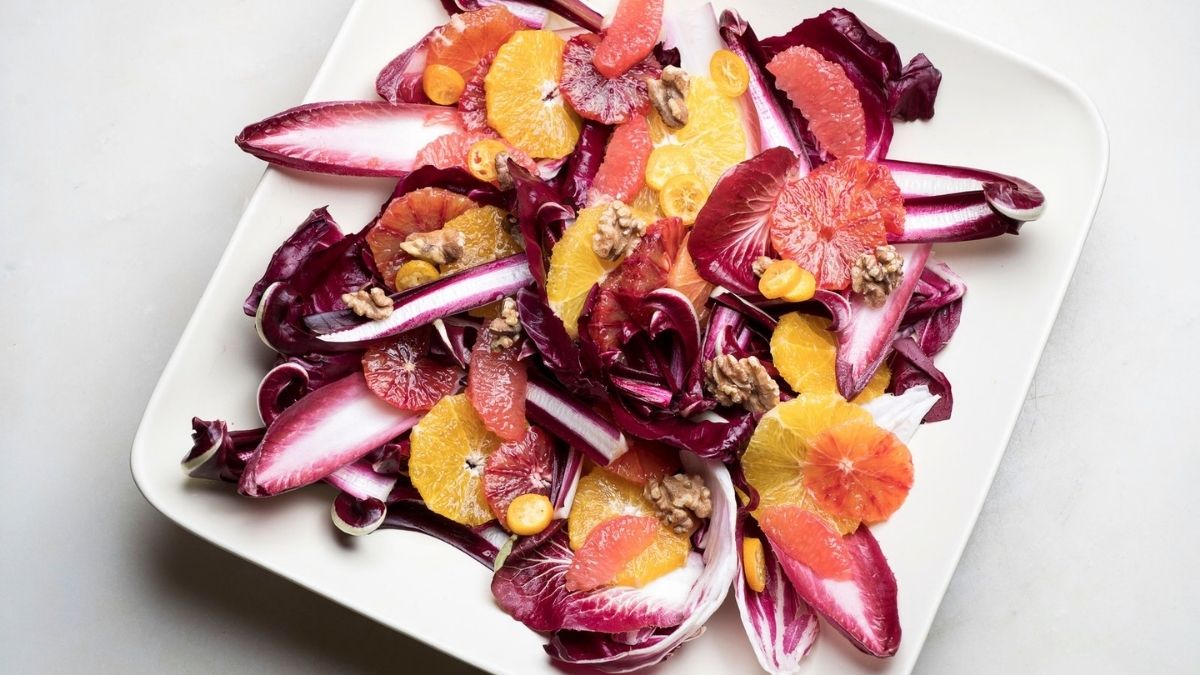Chicories are crisp, bright greens with a mildly bitter flavour that help us get through winter. They can range from crisp pale yellow, endive petals to magenta-speckled radicchio leaves and wildly curly frisée, looking more like flower petals than your ordinary salad greens.
Chicories are similar to lettuces, but they are heartier and have a bitter flavour. They are primarily planted as cool-season crops that bloom in late autumn (and last in temperate climates through early spring). Chicories like Belgian endive, curly endive, escarole, and radicchio provide a lot of flavour to seasonal fall and winter meals, whether in salads, soups, or braises, so you may have come across them.
Chicory is a root that has been farmed for thousands of years worldwide. Chicory has been used as a medicinal plant since the early Egyptian civilization. When roasted, chicory takes on a darker brown colour and has been used as a coffee ingredient since the 1700s. While the exact timing is unclear, the Continental Blockade of 1808 in France was a watershed point for Chicory and its use as a coffee additive or even substituted. It was utilized as a coffee ingredient to extend the supply of coffee during various significant events around the world. When things were tough, it was also used to replace coffee entirely. While this is true, it did grow enthusiastic support and love through time, and it is something that many people around the world appreciate to this day.
What are Chicories?
Chicories (Cichorium intybus) is a tough, bitter-flavoured green vegetable closely related to lettuce that comes into season in late autumn. They go well with creamy cheeses, nuts, and fruits in salads, but their toughness also lends to sautéed and roasted dishes.
Chicory plant roots have long been used as a coffee replacement. Chicory root resembles coffee in appearance and flavour, but it contains no caffeine. In the nineteenth century, its use as a coffee ingredient and alternative became popular in France and French colonies, such as New Orleans.
What are the Varieties of Chicory Greens?
Chioggia Radicchio: A tiny, soft magenta and white cabbage is the most prevalent type of radicchio.
Belgian Endive: Belgian endive has small oblong heads with stiff pale yellow and white leaves that are closely packed.
Red Belgian Endive: Small rectangular heads with tightly packed, rigid magenta and white leaves characterize Red Belgian Endive.
Curly Endive (Frisée): Frisée (curly endive) is a light green and yellow head of greens with curry leaves.
Escarole: Escarole is a massive head of bitter-tasting leafy greens that resembles Boston lettuce (also known as butter lettuce).
Speckled Radicchio: Speckled Radicchio is a mix between radicchio and escarole with delicate leaves that is beautifully speckled.
Treviso Radicchio: Color and flavour are similar to chioggia radicchio, but it grows in longer, looser-leafed heads.
Castelfranco Radicchio: Castelfranco Radicchio has delicate tasting leaves and creamy white leaves with magenta speckles.
What does Chicories Taste Like?
Chicories can have a bitter, earthy flavour, but they can also be sweet depending on which ones you choose—and how you match them with other flavours and textures. Other chicories are more challenging than others (curly endive), and some have softer, more delicate leaves (like Belgian endive), while others appear to be leafier (escarole). Chicory root is bitter while raw, but roasting changes that. Inulin (a prebiotic fibre) in the root is transformed to oxy methyl furfurol, which has a coffee-like scent during the roasting process (but not flavour). Chicory has a distinct flavour profile: robust, toasted, and nutty, with hints of burned sugar.
How to Wash and Prep Chicories?
Before usage, wash your chicories under cool running water and remove any discoloured or wilted outer leaves. After chopping, immerse the leaves in cold water for 30 minutes before using to reduce the bitterness. Any remaining leaves can be stored in a plastic bag covered in damp paper towels for one week.
To Prepare Endives:
Clip the stem, and the leaves will come apart if you’re using the whole for dipping or canapés. Remove the dense, crunchy center of the endive before cutting it for salads or sautéing: Half the endive lengthwise and make two angled incisions along the outside of the core with a paring knife. Cut crosswise into 1-inch sections after that.
To Make Curly Endive or Frisée:
Fold and gather the head of greens with a chef’s knife, creating little 1-inch pieces. When cutting a large head of frisee, tilt the knife and cut crosswise for easy cutting.
To Prepare Escarole for Salads:
fold and gather the head of greens with a chef’s knife, cutting short 1-inch pieces. Cut the leaves away from the center and leave them whole, or chop them into 3-inch pieces if using escarole.
What are the Health Benefits of Chicories?
Chicory has a lot of inulin, a form of water-soluble fibre that has been related to weight loss and better gastrointestinal health. Manganese and vitamin B6, two elements linked to brain development, are also present. Chicory has long been used to treat high blood pressure, appetite loss, stomach distress, constipation, liver and gallbladder problems, and a quick heartbeat.
1. Packed with the Prebiotic Fibre Inulin
By dry weight, fresh chicory root contains 68 percent inulin. Inulin is a fructan or fructooligosaccharide, and a carbohydrate comprises a short chain of fructose molecules that your body does not digest.
It is a prebiotic which feeds the good bacteria in your gut. These beneficial bacteria aid in reducing inflammation, the battle against harmful bacteria, and improving mineral absorption. Chicory root fibre may so benefit gut health in some ways.
2. May Aid Bowel Movements
Chicory root fibre contains inulin, which travels through your body undigested and nourishes your gut microbes, aiding digestion.
Studies have shown that inulin can help with constipation. According to four-week research, taking 12 grams of chicory inulin daily helped soften stool and dramatically increased bowel movement frequency in 44 persons with constipation.
Taking a daily dose of 10 grams of chicory inulin raised the number of bowel movements from 4 to 5 per week in 16 patients with low stool frequency (7). Most studies have focused on chicory inulin supplements, and thus, additional research on fibre as an additive is needed.
3. May Improve Blood Sugar Control
Chicory root fibre may help patients with diabetes control their blood sugar levels.
This could be due to inulin, which increases the growth of good bacteria involved in carbohydrate metabolism (the breakdown of carbohydrates into sugars) and insulin sensitivity (the hormone that helps the body absorb sugar). Chicory root fibre also contains chemicals such as chicoric and chlorogenic acids, demonstrated in mouse tests to improve insulin sensitivity.
In a two-month study of 49 women with type 2 diabetes, researchers discovered that eating 10 grams of inulin each day reduced blood sugar levels and hemoglobin A1c, a measure of average blood sugar, significantly more than taking a placebo. The inulin utilized in this study is known as high-performance inulin and is commonly used as a sugar substitute in baked goods and beverages. It differs slightly from other forms of inulin in terms of chemical composition.
4. May Support Weight Loss
According to research, chicory root fibre may regulate appetite and reduce overall calorie consumption, perhaps contributing to weight loss.
A 12-week trial of 48 overweight adults found that consuming 21 grams of chicory-derived oligofructose per day, related to inulin, resulted in a significant 2.2-pound (1-kg) average weight loss, while the placebo group gained weight.
In addition, oligofructose was found to help lower ghrelin levels, a hormone that drives hunger. Other studies have found comparable outcomes, focusing on inulin or oligofructose supplements rather than chicory root fibre.
5. Easy to Add to your Diet
Chicory root fibre is simple to incorporate into your diet. Because it’s occasionally used as an addition in packaged goods, you may already be taking it without recognizing it. Chicory root is rapidly being processed for its inulin. Due to its gelling qualities and mildly sweet flavour, it is utilized to improve fibre content or serve as a cube of sugar or fat substitute. However, it can also be utilized in home cooking. The whole root, commonly boiled and eaten like a vegetable, is available at some specialized shops and grocery stores. Furthermore, roasted and ground chicory root can be used as a coffee substitute to minimize your caffeine intake. Add two tablespoons (11 grams) of ground chicory root to 1 cup (240 ml) of water in your coffeemaker to produce this rich beverage.
How to Store Chicories?
These greens should be stored in the crisper drawer of your refrigerator, just like other greens, and it’s advisable to utilize them as soon as possible. In terms of keeping power, some are a bit chevalier than others. Curly endive, for example, has a shorter shelf life than other chicories and keeps best if washed and rolled in paper towels like lettuce leaves.
Chicories can survive a week or longer depending on storage circumstances and how fresh they are when purchased; for example, farmers’ market escarole will stay longer than supermarket escarole. Store them in the fridge, unwashed, until ready to use, much like other greens. If they’ve been exposed to too much moisture before you’re ready to utilize them, their shelf life will be jeopardized.
Conclusion
Chicory root fibre is made up mainly of inulin and comes from a plant in the dandelion family. It has been linked to various health advantages, including enhanced blood sugar control and intestinal health. Chicory root is widely used as a supplement and food ingredient, but it can also be used as a coffee alternative. If you want to receive the benefits of this fibre, consider boiling the whole root and eating it with your meal or making chicory root coffee.
Chicory has a little bitter and slightly sweet flavour. The vegetable has a flavour comparable to spinach, broccoli, or asparagus. Still, it’s more earthy and has a root-like flavour, which some people dislike since they prefer sweeter vegetables like carrots. Chicory is still required in a natural cup of New Orleans coffee! Discover the joys of Chicory in the current world with a trip down memory lane with a Cafe Au Lait and Beignet at Cafe Du Monde in New Orleans, USA.


